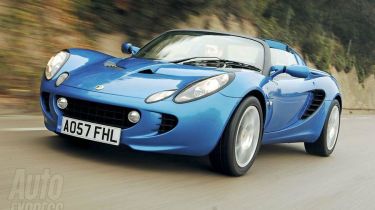Lotus Elise Convertible review
For pure driving thrills there is little to touch the lightweight Lotus Elise. Whether you’re planning to hit the road or attack a track, the Brit roadster excels.

Styling/Image
The basic design of the Elise is now over 12 years old, but the compact convertible wears its age well. A thorough facelift in 2000 resulted in a more aggressive look, although the car retains the same strong and lightweight extruded aluminium chassis. Buyers get a choice of three trim levels: S, R and supercharged SC. All cars get alloy wheels, while the range-topping SC is distinguished by a neat rear spoiler.
Interior/Practicality
If the Lotus has significant flaw, then it’s a lack of practicality. Wide sills make access a challenge, while the cabin space is tight. Luggage capacity is minimal too at 112-litres, meaning travelling light is compulsory. However, the low-slung driving position is perfect and the standard sports seats very comfortable. Central locking, a leather steering wheel and canvas roof are standard. An optional Touring Pack adds luxurious touches such as leather seat trim, extra noise insulation and iPod connectivity. There’s also a Sport Pack, which includes traction control and race-inspired dampers.
Engine/Performance
All versions use the same mid-mounted, high-revving 1.8-litre Toyota engine. In the entry-level S it produces just 134bhp, but thanks to the Elise’s incredibly low 860kg kerbweight it’ll sprint from standstill to 60mph in 5.8 seconds. Go for the R and power rises to 189bhp and you get a six-speed gearbox. At the top of the performance pile there’s the supercharged 217bhp SC, which scorches from zero to 60mph in just 4.6 seconds.
Driving experience
Few cars can match the Lotus when it comes driving fun. With its lightweight construction, compact dimensions and mid-engined layout, the Elise is incredibly agile. Adding to its appeal is direct steering that’s full of feed back and a precise, short throw gearshift. Better still, the ride is amazingly supple, allowing the two-seater to comfortably cope with the roughest of road surfaces. The only black mark is a lack of refinement, making the Lotus a wearing long distance companion.
Ownership costs
Get past the high list price and the Lotus makes a decent financial case for itself. All versions will return at least 30mpg, while the Toyota mechanicals are reliable and help to keep service costs down. Extra peace of mind comes in the form of a two year unlimited warranty. Sadly all models suffer from high CO2 emissions, with a year’s road tax for the Elise costing at least £210.
Safety/Environment
On the face of it, safety kit seems to be in short supply in the Elise. The driver and passenger get an airbag, but that’s about it! Instead the Lotus relies on its agility to avoid accidents, while powerful cross-drilled and ABS-backed brakes stand up well to repeated stops from high speed. Although high CO2 emissions are a problem, the roadster scores environmental points by being built in small numbers on home soil at the firm’s Norfolk based Hethel factory.
Our Choice: Elise S







